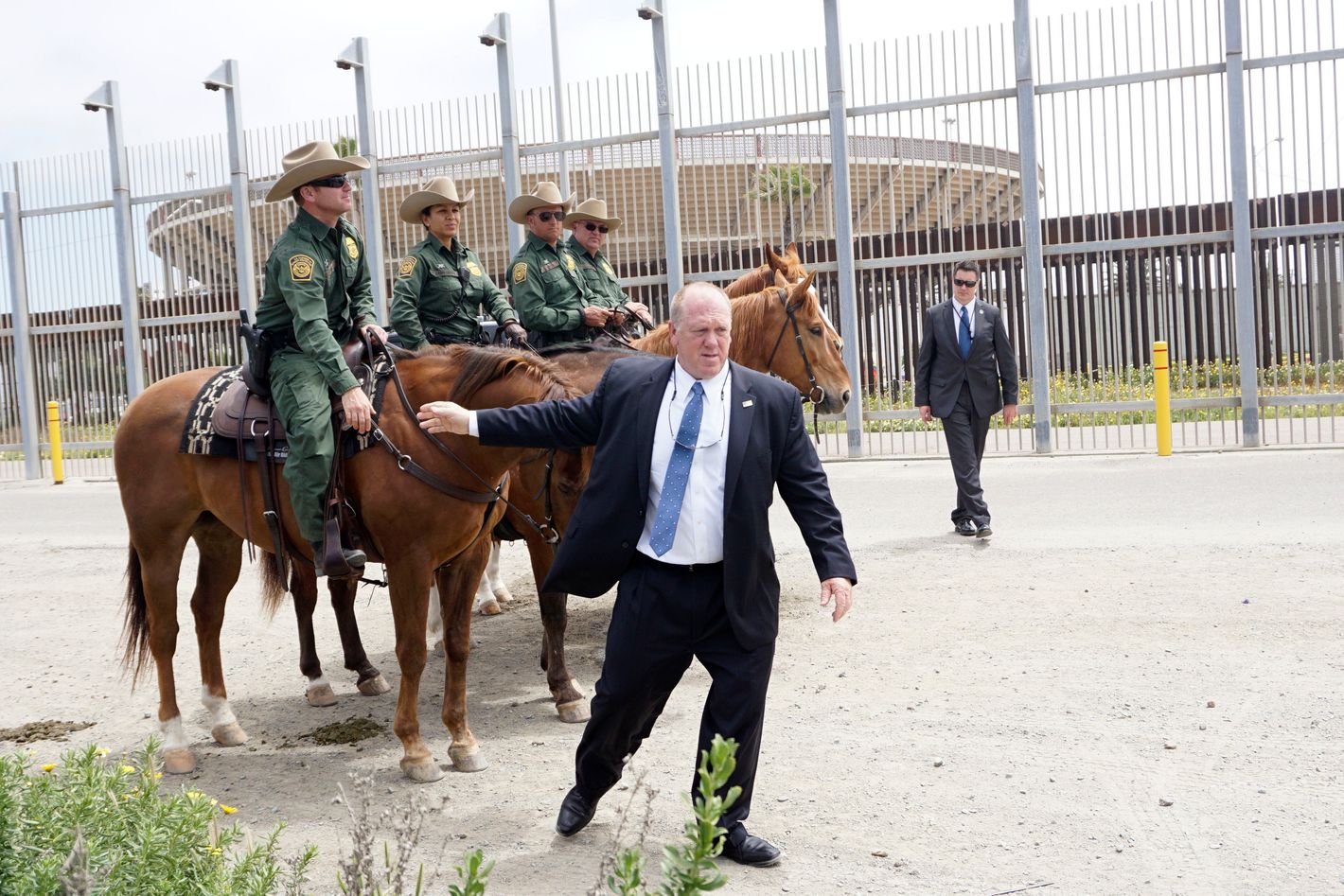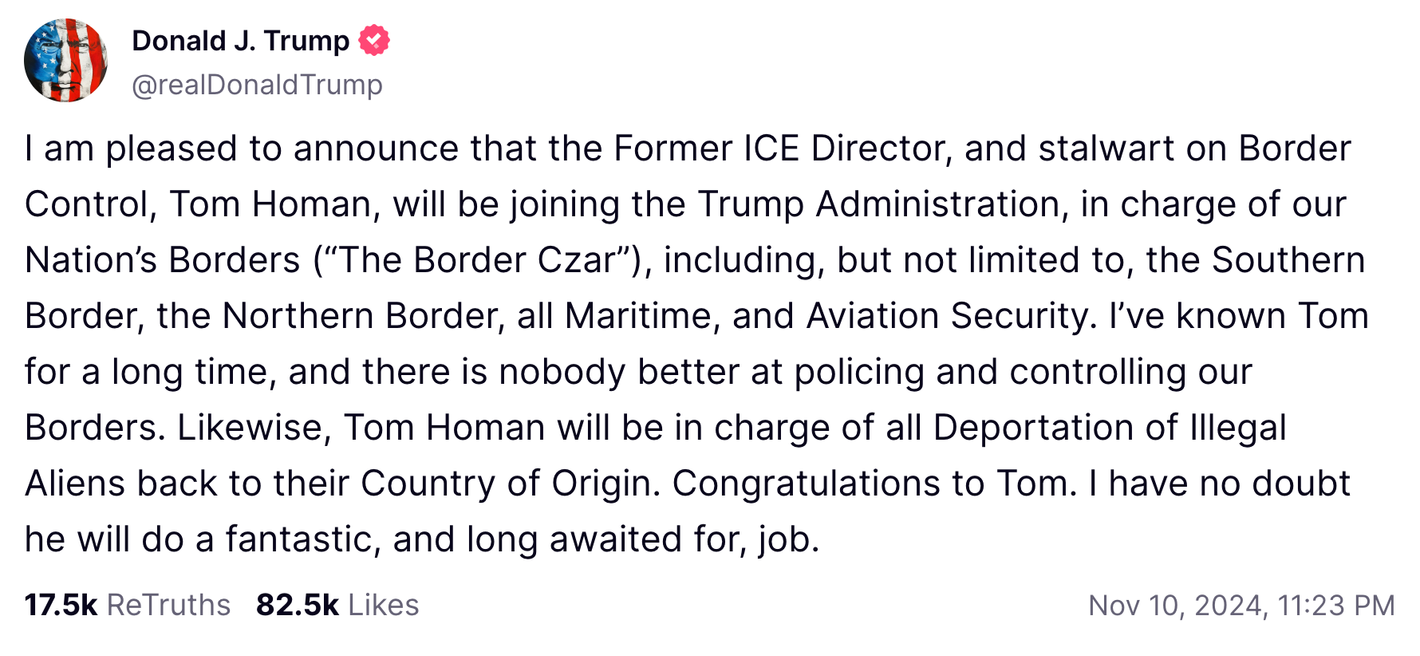
During his 2024 campaign, Donald Trump promised that if reelected, he would carry out the “largest deportation program in American history.” The Trump campaign never offered a full explanation of how, exactly, he planned to remove an estimated 11 million undocumented people currently in the United States. This would be a tremendous undertaking, politically, legally, and logistically.
Some people — even including some undocumented migrants — do not believe that Trump’s mass deportation program will be all that extreme. But Trump has seemingly confirmed that he plans to declare a national emergency and use the military on U.S. soil. And the Cabinet picks and top officials who will lead his deportation push include anti-immigration extremist Stephen Miller and “border czar” Tom Homan, who has promised “shock and awe” from day one.
Here’s everything we know about the Trump mass deportation plan so far.
What is mass deportation?
“Mass deportation” refers to a drastic and sweeping policy to remove people who are in the country without documentation. There is no precise definition for what constitutes “mass” deportation, but Trump has vowed to deport millions.
There are around 11 million undocumented people in the United States, according to the latest estimate from the Department of Homeland Security. This includes people who entered the country illegally, and those who entered legally then overstayed their visas.
Can Trump really deport 11 million people?
No. He can certainly ramp up deportations to a level never seen before in this country. However, rounding up all 11 million undocumented people and sending them back to their country of origin is not logistically possible.
More than 432,000 people were deported in 2013 under President Barack Obama, the highest recorded annual total (earning him the “Deporter-in-Chief” nickname). Annual deportations under during Trump’s first administration never exceeded 350,000, according to DHS figures.
Trump and his allies have not set a precise goal for how many people they intend to deport. When pressed on the logistics in August 2024, Trump’s running mate, J.D. Vance, said, “Let’s start with 1 million … And then we can go from there.”
Who is Thomas Homan, Trump’s new ‘Border Czar’?
Within a week of winning the 2024 election, Trump announced Thomas Homan, who was acting director of Immigration and Customs Enforcement in his first administration, will return as his “border czar.” That is not an official government title, but he’s expected to oversee both Trump’s border strategy and day-to-day operations.

Homan has worked in immigration enforcement for more than 30 years. As The Hill explains, he was seen as a moderate when he led ICE’s Enforcement and Removal Operations component under President Obama. But he was an early proponent of the Trump administration’s family separation policy, and he was a contributor to the Heritage Foundation’s “Project 2025” blueprint for a second Trump administration.
Who else will lead Trump’s mass deportation effort?
Trump has nominated South Dakota Governor Kristi Noem to lead the Department of Homeland Security, though she has no law enforcement experience.
Stephen Miller, who was the architect of the Muslim ban and family separation policy in Trump’s first term, will be back in the White House as deputy chief of staff for policy.
When would deportations start?
During his rally at Madison Square Garden in October, Trump declared, “On day one, I will launch the largest deportation program in American history.” He continued:
We’re gonna get these criminals out. I will rescue every city and town that has been invaded and conquered. These towns have been conquered, you know. They have been invaded and conquered. Can you imagine? Just as though a foreign enemy was invading, a military was invading. And probably just as vicious or more vicious. And we will put these bloodthirsty criminals in jail, or kick them out of our country, get them out of our country fast.
The United States is now an OCCUPIED COUNTRY, but it will soon be an occupied country no longer. November 5th, 2024 will be LIBERATION DAY in America. On DAY ONE, I will launch the largest deportation program in American history.
From Trump War Room @TrumpWarRoom: pic.twitter.com/V1meRvuLN0
— Donald J. Trump Posts From His Truth Social (@TrumpDailyPosts) October 29, 2024
Trump will almost certainly take steps to begin implementing his deportation plans on January 20, 2025, but the process is far too complicated to literally begin kicking people out on day one.
What are the logistical problems?
ICE has around 21,000 employees, including agents and non-law enforcement personnel. Experts say that is nowhere near enough agents to track down undocumented people on the scale Trump has talked about, and hiring and training more people would require a resources the administration probably doesn’t have.
As Aaron Reichlin-Melnick, policy director at the American Immigration Council, told the BBC, the arrest of an undocumented migrant is just the start of a long and complicated process:
[Post-arrest] detainees would need to be housed or placed on an “alternative to detention” programme before they are brought before an immigration judge, in a system with a years-long backlog. Only then are detainees removed from the US, a process that requires diplomatic co-operation from the receiving country. “In each of those areas, Ice simply does not have the capacity to process millions of people,” Mr Reichlin-Melnick said.
What exactly could Trump do on day one?
There are a variety of actions Trump could take via executive order in his first 100 days. According to Politico, his team is already thinking about how to craft executive actions that will withstand the legal challenges that blocked parts of his first term agenda. And since he appointed more than 200 federal judges in his first term, he’ll likely face a much friendlier judiciary this time around.
Some policies and programs that Trump is expected to end quickly include:
• A visa-free humanitarian parole process for some residents of Cuba, Haiti, Nicaragua and Venezuela.
• The CBP One app, a mobile app rolled out by the Biden administration that let migrants set up appointments to seek asylum.
• A memo issued by Homeland Security Secretary Alejandro Mayorkas in 2021 that said people who threaten national security and public safety should be prioritize for deportation, and directed ICE officers to learn “the totality of the facts and circumstances” about a person’a criminal conviction before deciding to deport them.
Will the National Guard be used for deportations?
The National Guard has been involved in border security since the George W. Bush administration, but currently the military only takes part in non-law enforcement activities, like surveillance, vehicle maintenance, and installing barbed wire, according to the AP.
Trump and his advisers have repeatedly talked about using the military to execute his deportation plans, though the Posse Comitatus Act says the U.S. military can’t be deployed against civilians. In an interview with Time magazine, Trump said that doesn’t matter because, “Well, these aren’t civilians. These are people that aren’t legally in our country. This is an invasion of our country.”
On the campaign trail, Trump said he would invoke the Alien Enemies Act, which lets the president deport noncitizens from countries that the U.S. is at war with. The U.S. is not currently in any declared war, but the Trump administration may try to argue that the 1798 law can be invoked because the so-called migrant “invasion” amounts to foreign aggression.
Many interpreted a single-word Truth Social post from Trump on November 18 as confirmation that his plans involve a national emergency declaration and deploying the military. The Hill explains:
On his Truth Social site, Trump at 4:03 a.m. EST reposted Tom Fitton, the president of Judicial Watch, a conservative organization that’s been active both in courts and on social media regarding a number of culture war issues, including questioning the legitimacy of elections.
“GOOD NEWS: Reports are the incoming @RealDonaldTrump administration prepared to declare a national emergency and will use military assets to reverse the Biden invasion through a mass deportation program,” Fitton wrote.
Trump labeled this, “TRUE!!!”
How much will mass deportation cost?
When asked about the cost two days after the election, Trump said it doesn’t matter.
“It’s not a question of a price tag. It’s not — really, we have no choice,” Trump told NBC News. “When people have killed and murdered, when drug lords have destroyed countries, and now they’re going to go back to those countries because they’re not staying here. There is no price tag.”
An October 2024 report from the American Immigration Council, an immigration rights research and policy firm, estimated that a one-time mass deportation operation would cost at least $315 billion in direct budgetary costs to the federal government (i.e. the costs of arresting and detaining undocumented people, not the economic impacts). AIC estimates a longer-term effort to expel 1 million people a year over more than a decade would cost $88 billion annually.
Will the Trump administration put people in camps?
That’s what Trump team members have said, but now some Trump advisers don’t like that people are using the term “camps.”
The U.S. will need huge new detention facilities to carry out the kind of operation Trump is talking about. About a year ago, Stephen Miller started talking to the media about what these military-constructed facilities would look like, referring them as “camps.” The New York Times reported in November 2023:
Mr. Miller said the new camps would likely be built “on open land in Texas near the border.” He said the military would construct them under the authority and control of the Department of Homeland Security. While he cautioned that there were no specific blueprints yet, he said the camps would look professional and similar to other facilities for migrants that have been built near the border.
But two weeks after the election, Rolling Stone reported that the Trump team is now worried about the association with Nazi concentration camps, so advisers and surrogates are being urged stop using the term during the transition.
“I have received some guidance to avoid terms, like ‘camps,’ that can be twisted and used against the president, yes,” a “close Trump ally” told the magazine. “Apparently some people think it makes us look like Nazis.”
Will there be family separations?
Trump has not ruled out reinstating his first term policy of separating families at the border, and many U.S. citizens will have their families split up if he carries out his mass deportation plans. The U.S has an estimated 4.7 million mixed status households, with a mix of both undocumented residents and residents with permanent legal status.
Tom Homan, Trump’s new “border czar” was recently asked by 60 Minutes if there is a way to carry out mass deportations without splitting up families.
“Of course there is,” he said. “Families can be deported together.”
Cecilia Vega asks: “Is there a way to carry out mass deportation without separating families?”
“Of course there is. Families can be deported together,” says Tom Homan, head of ICE during Trump’s family separation policy. https://t.co/If9G1sNEzj pic.twitter.com/TIWhi25Vdu
— 60 Minutes (@60Minutes) October 28, 2024